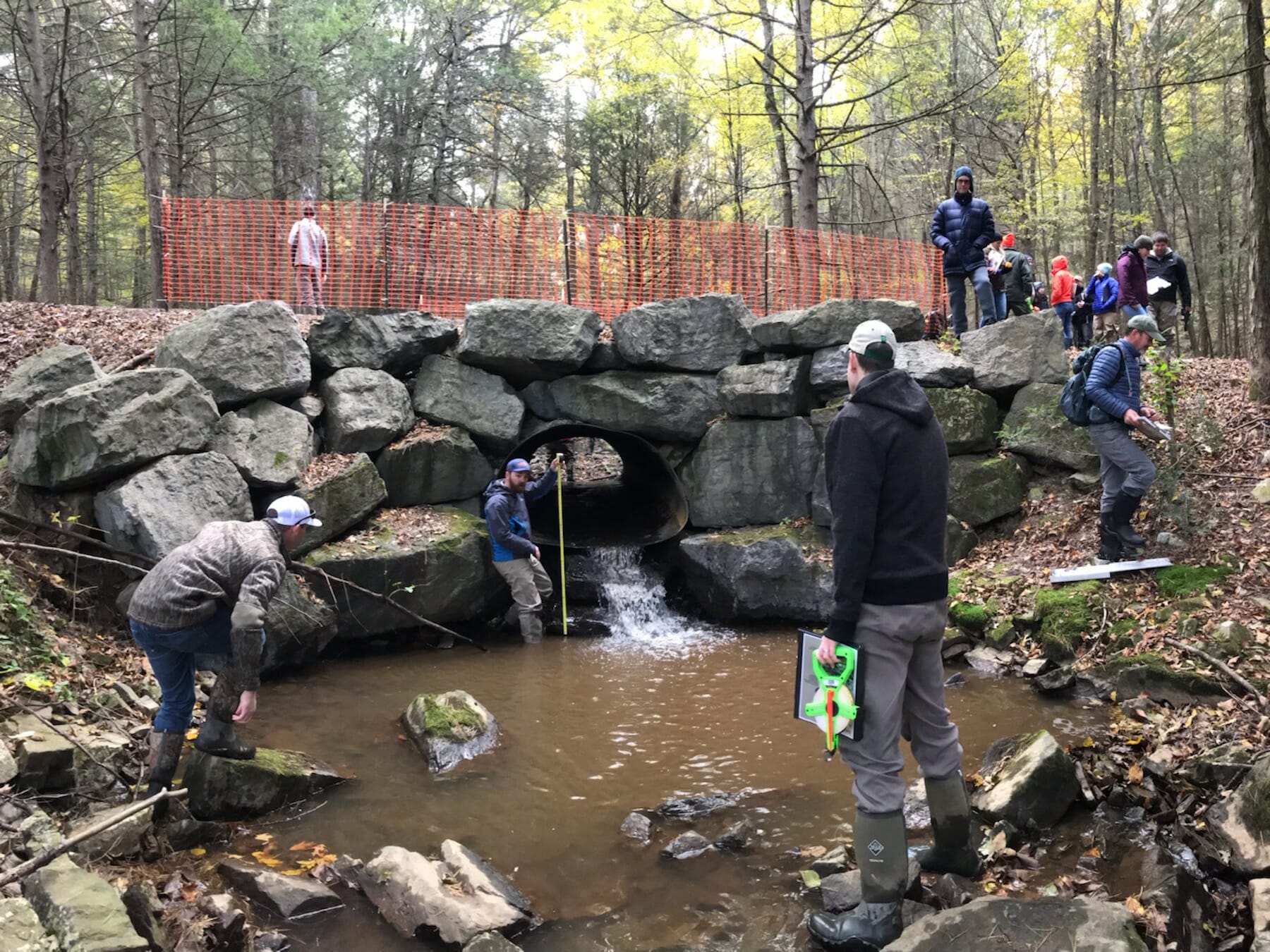In addition to in-classroom training during a recent TU and U.S. Forest Service stream simulation training workshop, a day was spent in the field to reinforce classroom lessons and
to help participants gain hands-on experience with field measurements.
By Amy Wolfe
In late October 2018, Trout Unlimited hosted a five-day training workshop put on by the U.S. Forest Service in State College, Pa.
As rain events become more frequent, intense and severe, undersized and/or failing culverts that lack flood resilience are causing localized flooding and increasing the burden of maintenance and associated costs, particularly for local townships. It is often these very same culverts that are also blocking aquatic organism passage, which is especially important to the eastern brook trout as they often need to access upstream coldwater habitat for food and reproduction success.
The workshop was an opportunity to learn how to simultaneously address both challenges. The workshop, titled “Stream Simulation Design Approach for Providing Aquatic Organism Passage at Road-Stream Crossings,” presented an ecosystem-based approach for designing and constructing a channel through the road-stream crossing structure that reestablishes physical and ecological continuity along the stream corridor.
The training attracted more than 50 engineers, biologists, hydrologists and conservation planners from federal and state agencies, conservation districts, the private sector, and non-profits, most of whom work in the Chesapeake Bay watershed in Pennsylvania. With funding from a National Fish and Wildlife Foundation grant through its Chesapeake Bay Stewardship Fund, TU was able to cover all costs associated with bringing the USFS’s Aquatic Organism Passage Design Team experts to central Pennsylvania.
For approximately four and a half days, the USFS design team provided instruction that covered every aspect of the stream simulation design process, beginning with assessment and prioritization of crossings at a watershed-wide scale, continuing through with site measurements, structure selection, flood hydrology, sediment analysis, discharge estimates, contract preparation, construction and monitoring. Workshop participants reported that the training was extremely worthwhile, as evidenced by comments made to TU following the workshop.
Bill Zemaitis, principal of SV LLC, commented: “As an environmental consultant and professional wetland scientist, I found the Aquatic Organism Passage training to be a great engineering alternative to apply when and where fish and herpetofauna conservation measures are needed. I plan to work with clients and engineers to find opportunities to apply this method and reduce road crossing environmental impacts on wild trout and turtle populations.” Rebecca Dunlap, an aquatic biologist with the Pennsylvania Department of Environmental Protection’s Regional Permit Coordination Office, said the workshop was helpful for her and three co-workers.
“The training was an excellent opportunity and we gleaned a lot of useful information,” Dunlap said. “While we are not directly involved in the design or installation of these crossings, we do permit crossings routinely. The training certainly provided us with a good base of knowledge so that we can ask more appropriate questions during the permit process. Hopefully in the future we can persuade the applicants into considering more appropriate crossings.”
This USFS workshop was the second one held in Pennsylvania in the past three years. Along with The Nature Conservancy, TU co-hosted this same workshop in November 2015 for approximately the same number of participants. As Pennsylvania conservation professionals, roadway engineers, local townships and others work to address the ever-increasing need for flood resiliency in our road infrastructure – coupled with widespread efforts to protect and restore disappearing coldwater habitat for eastern brook trout—the need for stream simulation design methodology and training is an obvious cost-effective win-win approach for achieving both goals at once.
As a result, TU anticipates the demand for the USFS’s “Stream Simulation Design Approach for Providing Aquatic Organism Passage at Road-Stream Crossings” is only likely to increase in the coming years.
Amy Wolfe is the director of TU’s Northeast Coldwater Habitat Progarm. She is based in Lock Haven, Pa.



